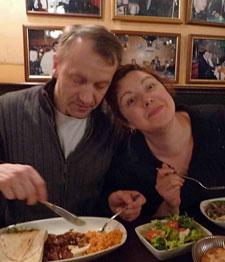In Toronto my life is full — full of friends, full of work, full of events and nights out and nights in with people I enjoy. Along with most other citizens of that fair city making plans for brunch or dinner out involves a daytimer, reservations and a sense of what three weeks or even a month down the road looks like.
But when you don’t have a day job, know the phone number of only four other people and haven’t figured out how to decipher the city’s event listings due to a lack of native language skills, one’s social calendar can magically open right up. And, as liberating as that might sound, after three months of “all the time in the world” maybe it’s time to dust off the PDA and get out there.
Round one: Make a plan
Okay, so maybe not the most organic way to create community, but when you’re on a “limited time offer” waiting around to let things take their natural course isn’t exactly an option. I could sit by the phone in the hopes that someone I’ve met along the way will become enamoured by me in the two minutes that we spend together and want to hang out more. I could also get hit by lightening. In reality both are options of equal probability. Or I (or more likely my wife who is far more outgoing) could make the first move.
People who know people you know make great potential friends. You automatically have something in common and can swing an introduction, in person or online, which makes it less like a cold call and less intimidating than walking up to a complete stranger and striking up a conversation.
The plan was to ask everyone we knew if they knew someone in Berlin and if they could hook us up, share contact information and kick start our social calendar. I was delighted by the favourable response and before I knew it we had gone from zero to 10 in just over a week. We had collected a musician, artist, flight attendant, well-connected continental lesbian, ex-punk rock social worker and his metal worker boyfriend, anarchist activist, three journalists and a mother/father combo with a newborn. Add that to our new actress and composer “friends” and it was a dinner party in the making.
Round two: Make the first move
My philosophy when it comes to making the first move in any context is that if it fails and you get no favourable response in return, chances are the other person isn’t interested. Not only are they not interested, the likelihood of them remembering you next time you encounter them is slim to none. Of course it’s important to be as charming as possible without a) ingratiating yourself to the point of nausea, b) smelling of desperation or c) prompting them to get a restraining order.
Round three: Be persistent
I’ve come to learn that unless the people you are trying to woo are also new to town, chances are they already have a full dance card. Trying to fit into their lives without them feeling like they need to choose option “c” above is a delicate dance. How many emails suggesting a beer date are too many? How many times an hour can you send them a text message? Is it inappropriate to email, text message and call all in one day? Is it too much to casually walk back and forth in front of their house in the hopes that you’ll bump into them? It’s a fine line.
Round four: The face-to-face
Our first face-to-face social engagement was initiated by the woman whose apartment we are renting for three months. She had invited us out for a beer with her boyfriend at the neighbourhood bar to introduce us to him and talk business.
In speed-community building the in-person outing is the moment of truth. It’s one thing to have lovely and polite email and phone conversations and another to share an alcoholic beverage (or seven) and see where the evening leads. After several beers and vodka shots it was time to call it a night. There were goodbye hugs and promises to hang out again.
In the sober light of day the morning after there comes the ever-familiar feeling doubt. Did we really have a nice time? Was I the only one who felt like we could be friends? Did the haze of booze cloud my assessment of the situation and really I was obnoxious? Should I call and thank them for a lovely time?
I was relieved to discover that I wasn’t alone in believing the four of us were creating a burgeoning friendship. Two days after our beer date we were invited to a party at the boyfriend’s apartment and the possibility of us paying a damage deposit along with our rent was brushed aside in favour of future social get-togethers without the awkwardness of money. A success all ’round.
Round five: Knowing when enough is enough
We recently celebrated our monthiversary in Berlin and during that time have hung out on several occasions with more than just ourselves. As the weeks progressed so did the amount of time we spent getting to know other people. And if things keep going in this direction, it won’t be long before we start looking at what’s on our calendar two weeks ahead. But by the year’s end if we’re booking a month out, enough will certainly be enough.

 Why you can trust Xtra
Why you can trust Xtra


